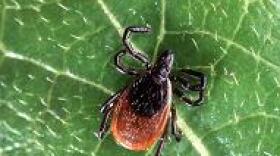May is Lyme Disease Awareness month, but at least one area scientist is advocating for moving the campaign to April, to get ahead of tick emergence. Meanwhile, Dutchess County — at the epicenter of the disease — is aiming to educate the public in a different way this year.
Dr. Richard Ostfeld is a disease ecologist at the Millbrook-based Cary Institute of Ecosystem Studies. He says if we want to get a leg up on tick-borne illness we need to become vigilant earlier in the season.
“It used to be back 20 years ago or so that we could count on the nymphal ticks, the stage that’s the most dangerous when it comes to disease transmission, we could count on them coming out about mid-May, peaking at the end of May or even into early June and then going on their annual decline throughout the rest of the summer,” says Ostfeld. “But we’ve been finding that as the climate warms, and it has warmed over the past 20 years, they’re coming out earlier and earlier. So they’re peaking more like mid-May and some of them are appearing as early as late April.”
As such, he says it would be wise to begin public education campaigns earlier in the season, like in April. He says this year the nymphs, which are about the size of a poppy seed, do not appear to be coming out early, likely because of the long, cold winter that seeped into spring. However, those hoping the harsh Northeast winter will make for a milder tick season are likely out of luck. Ostfeld explains that there is no indication that fewer ticks will be a silver lining. In fact, he says it could be the opposite with snow having provided an insulating layer that may be protective.
“Another possible suggestion for Lyme Awareness month would be tick-borne disease awareness,” Ostfeld says. “It doesn’t quite roll off the tongue as easily, but it’s true that as go the nymphs so go not just Lyme but several other tick-borne diseases like Babesiosis and Anaplasmosis and then this relative of the Lyme disease bacterium called Borrelia miyamotoi, which we now know is present and causing disease in various parts of the Northeast.”
Ostfeld is co-author of a study published in February in Philosophical Transactions of the Royal Society B that showed ticks carrying Lyme disease are emerging earlier and spreading into new geographic regions. He says data for the study was used for projections and forecast that by the 2050s nymphal ticks will be coming out as early as the beginning of May, several weeks earlier than in the 1990s. Ostfeld says there is evidence of ticks moving up in latitude and altitude under climate warming.
“The reasons for that are not always clear. What it is about the higher latitudes and higher altitudes that makes life more hospitable for ticks, but the pattern was definitely a widespread one”, says Ostfeld. “So we can expect ticks to be moving more into the Adirondacks, which they already are beginning to do, more into northern New England, up into Canada. The Canadians are very worried about this latest American export that’s coming across the border into Quebec and Ontario.”
He says the movement also is toward western New York. The Hudson Valley and Dutchess County in particular is an epicenter of Lyme disease. Donna Bolner is assistant majority leader of the Dutchess County Legislature and chairperson for the Dutchess County Tick Task Force. She says she is paying attention to moving Lyme awareness up on the calendar.
“Actually this year I kind of went with that,” says Bolner. “I actually moved our tick task force meetings up a month so that we actually started in March and then we had April and then May.”
The task force, which in the past has held in-person forums, is for the first time holding an education webinar, with presenters from around the Northeast. She says the May 13 webinar will be recorded and then made available on the county legislature’s web site. Bolner says she is also acting earlier on education and passing out tick removal kits.
“So we’ve tried to look at how early can we get in to get to see some of these groups that we feel are, are normal residents here in Dutchess County but they are at risk,” Bolner says.
Groups such as hikers, hunters, and golfers. Democratic Assemblymember Didi Barrett represents portions of Columbia and Dutchess Counties.
“The sooner people are informed and the more broadly people are informed the better we are,” says Barrett. “Education is the best weapon we have.”
The webinar will begin at 8:30 a.m. with presentations starting at 9:00 a.m. A limited number of access codes are available for the May 13 event by contacting the Dutchess County legislative offices.







